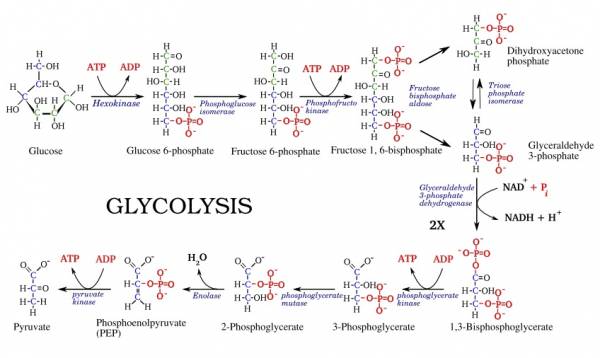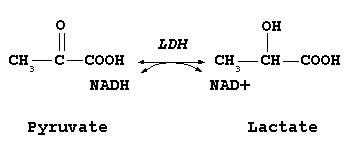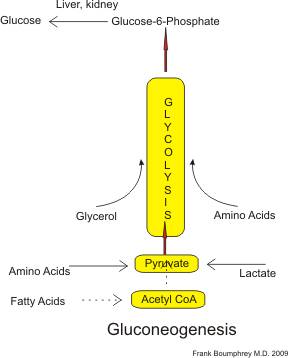Admit it. For years you have blamed high-effort, short-term muscle fatigue on lactic acid accumulation. It’s all over exercise physiology texts and Internet sites. Lactic acid accumulation is the reason high-effort, short-term activities shut down the muscle activity sooner rather than later. Conventional wisdom, despite being based on antiquated research, does make sense. You work as hard as you can, lactic acid accumulates rapidly, you’re unable to oxidize it aerobically, your muscles then become acidic, and your effort deteriorates into a low-level effort or comes to a screeching halt.
This is a true scenario, but is lactic acid to blame? Here is an update on this belief and the new research that supports it.
High-effort activity that requires the process of glycolysis (breakdown of stored muscle glycogen to produce ATP) results in the formation of lactic acid (pictured to the right). However, lactic acid is immediately split into lactate and hydrogen and does not remain as itself in muscle tissue. Lactate and hydrogen each face a different consequence.
Lactate may stay in the cells to be used as energy or move to active and inactive muscles and used as energy. The use of lactate as fuel within the muscle itself varies with how well a person’s endurance muscle fibers are trained aerobically. Lactate can also be sent to the brain and heart for fuel, or to the liver to be converted to glucose.
The function of your brain is critical. When exercising, your body needs to maintain a steady supply of glucose to the brain to remain operational. Ever wonder why you get light headed following intense work? Yep, a lack of glucose supply. By the way, the manufacturing of new glucose in the liver during exercise is called gluconeogenesis. Interestingly, lactate is the most important facilitator of this process.
Great, but what then creates muscle fatigue if it’s not lactic acid accumulation?
Remember, glycolysis results in lactate and hydrogen formation. Hydrogen ion (H+) accumulation can increase muscle acidity, but most of it is buffered via the bicarbonate buffer system, then converted to water and carbon dioxide, and ultimately eliminated via expiration through the lungs. If the accumulation of lactate and hydrogen is extreme, some research evidence shows it may interfere with muscular contractions. However, recent evidence suggests this is questionable.
Come on, man! What then is the cause of muscle fatigue if not for lactic acid accumulation nor the aforementioned? Well, here is what scientists have concurred. Muscle fatigue at non-sustainable workloads seems to be a result of the accumulation of other metabolites such as inorganic phosphates along with the inability to maintain the rate and force of contraction via the loss of potassium from inside muscle cells.
So, lactic acid itself as a muscle fatigue expeditor is nonsense? Let’s look at it another another way. Trainees or active humans obtain about one third of their total carbohydrate energy from lactate. The remainder is from circulating blood glucose and stored muscle glycogen. In order to burn lactate as fuel for muscles, you can either burn it directly or convert it to glucose and then burn it. In research on untrained subjects, about 75% of the lactate used was directly oxidized. In trained subjects, about 90% was directly oxidized. Trained subjects also burned more overall lactate. (So basically, it pays to be in shape.)
What does this mean? Endurance training stimulates the body to use more lactate and use it more efficiently. It was concluded in trained subjects that lactate is a preferred energy source over glucose. This spares glycogen stores, giving you more endurance.
Here are a few more tidbits to help clarify the issue:
When glucose is broken down through glycolysis the byproduct is pyruvate. Pyruvate can then be pushed into the Krebs cycle. This creates energy through the aerobic system or energy can be created via lactate. As you now know, lactate is not a waste product but a viable fuel source for continued muscle contraction. Converting pyruvate into lactate results in quicker energy production as opposed to the longer oxidative process.

How fast can pyruvate be converted into lactate? Recent research shows it’s dependent on the availability of oxygen. More oxygen equates to more pyruvate oxidized even though the amount is small. Regardless, if you’re in better shape, the glycolysis byproduct pyruvate can be converted to lactate and serve as future energy.

Lactate accumulation only occurs when its production is greater than its clearance. Here’s an example for you. Pour water down a drain slowly. The water drains at the same rate as it is poured. Now, pour the water at a higher volume and a greater flow will compromise drain’s ability to empty and the water level will rise in the reservoir.
Your body is similar to the aforementioned example. Lactate is cleared from the body by the liver, heart, brain, and muscles. Lactate produced by the large leg and back muscles can be used by other less active muscles such as the deltoids and abdominals. These less activated muscles – combined with oxygen intake – will convert lactate back to pyruvate to provide more fuel. Pyruvate can then be used aerobically in less taxed muscle or it can become recycled to support greater-demand contractions such as demanding lower-body exertions.
 Finally, to be an efficient energy source for another muscle group, lactate or pyruvate must be converted into a more efficient form. Therefore, circulating blood lactate is filtered through the liver where it is ultimately converted back into pyruvate, then to glucose through the gluconeogenesis process. The newly-formed substrate can then be returned to the muscle as an immediate fuel source or stored as glycogen to be used at a later time.
Finally, to be an efficient energy source for another muscle group, lactate or pyruvate must be converted into a more efficient form. Therefore, circulating blood lactate is filtered through the liver where it is ultimately converted back into pyruvate, then to glucose through the gluconeogenesis process. The newly-formed substrate can then be returned to the muscle as an immediate fuel source or stored as glycogen to be used at a later time.
So, what can you take from this discussion? Lactic acid is not the cause of muscle fatigue as has been the common thought for years. Muscle fatigue and consequent inefficiency is due to the accumulation of other metabolites such as inorganic phosphates and the inability to maintain the rate and force of contraction via the loss of potassium from inside muscle cells.
Lactate production from high effort exercise is a good thing. Lactate is actually a provider of more energy for muscle contraction. Lactate also creates fuel for the brain and heart and can be converted to glucose in the liver.
In the end, lactic acid is not the issue. Lactate is, and it’s your pal!
References:
1. Lactate and Lactic Acid: Dispelling the Myths, www.cyclingnews.com.
2. H. Westerblad, J.D. Bruton, and J Lannergren, “The Effect of Intracellular pH on Contractile Function of Intact, Single Fibers of Mouse Muscle Declines with Increasing Temperature,” Journal of Physiology 500 (1997): 193-204.
3 Messonnier, Laurent A., Chi-An W. Emhoff, Jill A. Fattor, Michael A. Horning, Thomas J. Carlson, and George A. Brooks, “Lactate Kinetics at the Lactate Threshold in Trained and Untrained Men,” Journal of Applied Physiology 114 (2013): 1593-1602.
Lactic acid graphic courtesy of Shutterstock.
Glycolysis chart by Rozzychan [Public domain], via Wikimedia Commons.
Gluconeogenesis chart by Boumphreyfr (Own work) [CC-BY-SA-3.0 or GFDL], via Wikimedia Commons.






